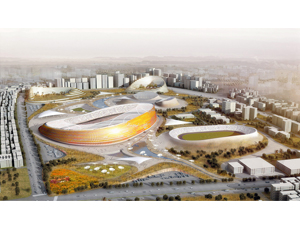
A consortium led by Australia’s LAVA has won an international competition to design a national stadium and sports village in Addis Ababa, Ethiopia. Its concept blends traditional Ethiopian architectural and construction practices with new technology to create a quality, modern piece of infrastructure.
LAVA, or the Laboratory for Visionary Architecture, is an international network of designers with offices in Sydney, Shanghai, Stuttgart and Abu Dhabi. LAVA's consortium partners are Doha-based DESIGNSPORT and Ethiopia’s JDAW.
The team was selected by Ethiopia's Federal Sport Commission (FSC), which wants to replace the current 25,000-seat national stadium with a 60,000-seat stadium and related sports facilities. FSC wants to begin construction in 2014.
Traditional Ethiopian architecture includes examples of excavated historical structures, including ancient rock churches as well as dwellings and cisterns. The team's concept, which includes a sunken arena surrounded by grandstands formed from excavated material, captures elements of those traditional treatments in the stadium’s design.
In addition to housing the FSC, the new stadium and sports village will have arenas, sports halls, a running track, an aquatic center, a residential village, and retail and commercial zones, according to Chris Bosse, lead designer and director of LAVA.
“This man-made crater is a clever remodeling of the existing terrain and generates efficient spaces, optimizes environmental performance, minimizes construction costs and integrates facilities within the existing landscape,” says a LAVA company statement.
Bosse says the man-made crater is suitable for either flat or hilly ground. "Basically, we can excavate any terrain and use the land to create the stands,” Bosse says.
The "massob," a communal Ethiopian serving basket made from woven grass, inspired the facade material that wraps the stadium, adds Bosse. As seen from the top, the stadium structure's form recalls coffee beans, the main source of income in Ethiopia, and also the "mother womb," the 3.2-million-year-old skeleton of one of the first humans, Lucy, which was discovered in Ethiopia in 1974.
Design engineers are now left to grapple with the question of how to make the facility less costly while delivering on quality.
“One of the challenges may be to produce a low-cost stadium roof. We are thinking of using lightweight materials, possibly even bamboo so that there's a connection with high-tech engineering and low-tech construction and materials,” Bosse said.
Also envisioned is a picturesque stadium roof, which Bosse describes as “an intelligent membrane that appears like a cloud on the horizon of the vast Ethiopian sky, a lightweight tensile structure floating over the formed-earth landscape.”

Post a comment to this article
Report Abusive Comment